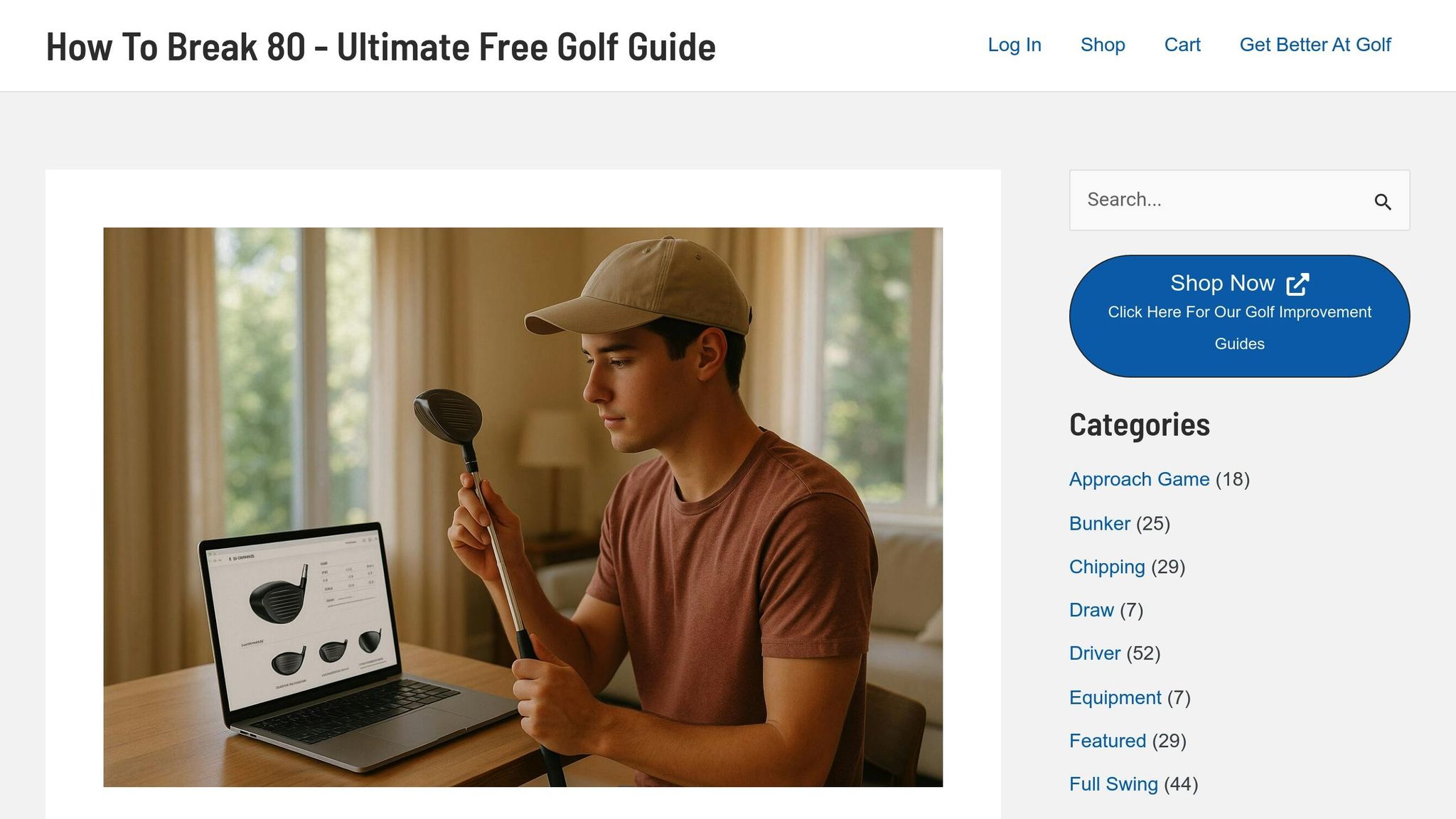Getting the right driver length for junior golfers is key to improving their swing mechanics and overall enjoyment of the game. Ill-fitting clubs can negatively impact balance, swing form, and confidence. Here’s what you need to know:
- Driver length depends on height and age. Clubs should match the child’s physical development and skill level.
- Too long or too short clubs create issues. Long clubs encourage flat swings, while short ones lead to upright swings.
- Adjust regularly. Kids grow fast, so reassess club fit every 3–4 months.
- Height-based recommendations:
- Ages 5–7: 33–35 inches
- Ages 8–10: 35–37 inches
- Ages 11–13: 37–40 inches
- Ages 14–16: 40–43 inches
- Ages 17–18: 44–45 inches (adult clubs may fit here).
Properly fitted clubs help young golfers hit more consistently, build confidence, and enjoy the sport. Always prioritize comfort and swing control over club length.
Junior Golfing Tips on Proper Club Sizing and Grip – Shaw TV Golf Tips – Mckenzie Meadows

How to Measure and Use a Driver Length Chart
Getting the right measurements is key to ensuring junior golfers have clubs that fit well and support their swing. Here’s a simple guide to help you measure and interpret driver length charts effectively.
Measuring Height for Club Fitting
Junior club sizing charts rely on a child’s height to determine the appropriate club length. To measure their height accurately, have the child stand barefoot against a wall. Use a flat object, like a book, to mark the top of their head, and measure the distance from the floor to the mark.
Most junior club sets come with recommended height ranges. Once you have the child’s height, you can use the chart to find the best club length for them.
Understanding Driver Length Charts
Junior driver lengths don’t follow the same formula as adult clubs. Instead of the standard 6-inch-to-1-inch ratio, junior clubs typically increase in length by 1.5 to 2 inches for every 3 inches of added height.
For example, if a junior’s height falls in the middle of a manufacturer’s recommended range (e.g., 48 inches in a 44–52 inch range), the clubs are likely a great fit. However, if their height is closer to the lower end, the clubs might feel a bit too long.
Driver Length Recommendations by Age and Height
Accurate height measurements are key to selecting the right driver length for junior golfers. Properly fitted drivers improve swing control, consistency, and distance – essential for developing young players.
Driver Lengths for Common Age Groups
Here’s a quick guide to matching driver length with age and height:
Ages 5–7 (Height: 42–48 inches)
Recommended driver length: 33–35 inches.
Ages 8–10 (Height: 48–54 inches)
Recommended driver length: 35–37 inches.
Ages 11–13 (Height: 54–60 inches)
Recommended driver length: 37–40 inches. At this stage, juniors often start generating more clubhead speed, so transitioning from ultra-light to slightly heavier shafts can be beneficial.
Ages 14–16 (Height: 60–66 inches)
Recommended driver length: 40–43 inches. For taller juniors nearing their full height, adult-length drivers (44–45 inches) may become a viable option as physical strength plays a bigger role in club selection.
Ages 17–18 (Height: 66+ inches)
Most juniors in this age group can use standard adult drivers (44–45 inches). However, those still refining their swing mechanics or not fully developed physically might prefer slightly shorter clubs.
| Age Group | Height Range | Driver Length | Key Considerations |
|---|---|---|---|
| 5–7 years | 42–48 inches | 33–35 inches | Emphasize balance and basic fundamentals |
| 8–10 years | 48–54 inches | 35–37 inches | Focus on coordination and control |
| 11–13 years | 54–60 inches | 37–40 inches | Transition phase; increasing swing speed |
| 14–16 years | 60–66 inches | 40–43 inches | Potential shift to adult clubs |
| 17–18 years | 66+ inches | 44–45 inches | Standard adult clubs for most players |
Why Regular Adjustments Matter
As junior golfers grow, their driver needs change – sometimes faster than you might expect. Growth spurts, which often occur between ages 10 and 14, can add 2–4 inches in height per year. A driver that fit perfectly six months ago might now be too short, leading to issues like standing too upright, hitting thin shots, or feeling that the club is awkwardly small. To keep up with these changes, it’s smart to reassess driver length every 3–4 months.
Swing development is another reason for adjustments. As juniors improve their strength and refine their technique, a slightly longer driver might help maximize their performance.
For families looking to save on equipment, adjustable drivers with extendable shafts are a great option. These clubs grow with the player, making them a practical and cost-effective solution.
sbb-itb-bcd8bdd
Other Factors When Customizing Driver Length
When it comes to customizing a junior driver, there’s more to consider than just age and height. Two key elements – swing speed and skill level – play a major role in ensuring the right fit.
Swing Speed and Skill Level
For younger players, having a properly sized and lightweight driver is essential to help them achieve their best swing speed. If the driver is too long, it can throw off their swing mechanics. Instead of swinging freely, they might slow down to maintain control over the club, which can hinder their development. This highlights why it’s so important to match the driver’s specifications to the player’s current abilities.
While longer shafts can extend the swing arc and increase clubhead speed, the real game-changer for distance is making solid, centered contact. Junior golfers often find it easier to hit the sweet spot with a shorter club, making it a more practical choice for improving their performance.
Summary and Additional Resources
Key Takeaways from the Chart and Guidelines
Choosing the right driver length for junior golfers involves more than just checking their age or height on a chart. While these factors are a great starting point, the real priority is finding a club that matches the child’s current skill level and physical development.
Junior golfers grow quickly, especially during growth spurts, so it’s a good idea to reevaluate their club fit every 3-4 months. Focus on consistent, solid contact over added length; shorter drivers often provide better control and help young players develop their skills more effectively.
Look for a driver that feels comfortable, encourages proper swing mechanics, and builds confidence. If you’re unsure, it’s usually better to go with a slightly shorter club rather than one that’s too long – this promotes better control and faster improvement.
Explore Resources from How To Break 80

Want to help junior golfers improve their game while ensuring their equipment is a perfect fit? Check out these resources from How To Break 80:
- Maximum Distance Video Course ($49.00): This course teaches techniques to maximize power and accuracy off the tee, helping young players make the most of their properly fitted driver.
- Essential Golf Improvement eBook Bundle ($19.00): Packed with drills, tips, and strategies, this bundle is perfect for building solid swing fundamentals that will grow alongside junior golfers as their needs change.
- Fix Your Slice & Hit a Draw Video Course ($99.00): Struggling with ball flight issues? This course offers step-by-step guidance to help junior golfers improve control and consistency – especially useful when adjusting to new driver lengths.
These resources are designed to support young players as they develop, ensuring their equipment and skills work together seamlessly on the course.
FAQs
How often should I check if my junior golfer’s driver length is still a good fit?
It’s smart to check your child’s driver length every 6 to 12 months, especially if they’ve had a growth spurt or their swing mechanics have noticeably changed. Kids grow fast, and using a driver that’s either too long or too short can impact both their comfort and performance on the course.
To get the right fit, regularly measure their height and match it with a driver length chart designed for junior golfers. Having the correct equipment not only enhances their game but also encourages them to build solid swing habits from the start.
What happens if a junior golfer uses a driver that’s the wrong length?
Using a driver that’s too long can make it tough for junior golfers to maintain control over their swing. This often results in higher ball flights, inconsistent shots, and less accuracy. On the flip side, a driver that’s too short can reduce swing speed and distance, making it harder to generate the right ball flight and power.
Picking the correct driver length based on a junior golfer’s age and height is key to boosting confidence, enhancing performance, and encouraging proper skill growth.
Are there adjustable golf drivers that can grow with my child, and how do they compare to fixed-length drivers?
Yes, there are junior golf drivers that can be adjusted to grow along with your child. These clubs are designed with adjustable features for both length and loft, making it easier to ensure the club fits properly as your child gets taller. This adjustability often means they last longer than fixed-length drivers, which are made for a specific size and can’t be altered.
Adjustable drivers are a smart choice for young golfers because they adapt to their changing needs and help support proper swing mechanics over time. In contrast, fixed-length drivers might need to be replaced more frequently as your child continues to grow.


